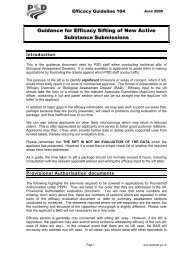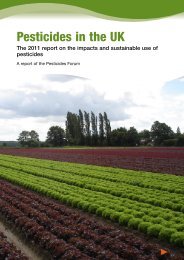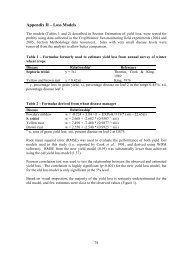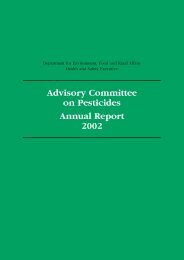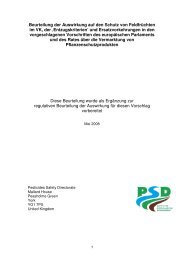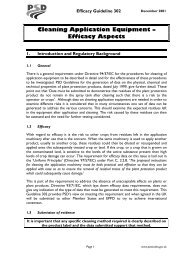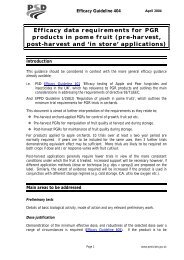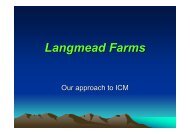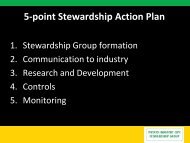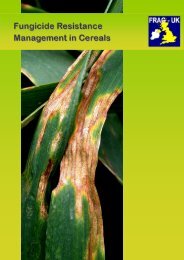Advisory Committee on Pesticides Annual Report 2001
ACP Annual Report 2001 - Pesticides Safety Directorate
ACP Annual Report 2001 - Pesticides Safety Directorate
You also want an ePaper? Increase the reach of your titles
YUMPU automatically turns print PDFs into web optimized ePapers that Google loves.
<str<strong>on</strong>g>Advisory</str<strong>on</strong>g> <str<strong>on</strong>g>Committee</str<strong>on</strong>g> <strong>on</strong> <strong>Pesticides</strong> <strong>Annual</strong> <strong>Report</strong> <strong>2001</strong><br />
Fungicides accounted for 37 percent of the total pesticide-treated area<br />
of mushrooms grown in Great Britain in 1999, disinfectants 36 percent,<br />
insecticides 25 percent, biological c<strong>on</strong>trol agents two percent and tar oils less<br />
than <strong>on</strong>e percent. In c<strong>on</strong>trast, disinfectants accounted for 80 percent of the<br />
total weight of pesticide active substances applied, fungicides for 16 percent,<br />
insecticides four percent, and tar oil less than <strong>on</strong>e percent.<br />
By area treated, the most extensively used fungicides were prochloraz,<br />
accounting for 88 percent of the total fungicide-treated area, used mainly<br />
during producti<strong>on</strong>, and carbendazim, comprising 11 percent, used during<br />
both producti<strong>on</strong> and casing. By weight applied, prochloraz accounted for<br />
71 percent of the total fungicides applied, with carbendazim comprising<br />
a further 27 percent.<br />
68<br />
The most extensively used insecticide formulati<strong>on</strong>s were permethrin<br />
(48 percent), pyrethrins/resmethrin (18 percent), diflubenzur<strong>on</strong> (17 percent),<br />
and methoprene (11 percent). The use of gamma-HCH was c<strong>on</strong>fined to<br />
periods between flushes or when the mushroom house was empty. By weight<br />
applied, diflubenzur<strong>on</strong>, used mainly during pre-producti<strong>on</strong>, accounted for<br />
65 percent of the total.<br />
In terms of area treated, sodium hypochlorite (81 percent) and formaldehyde<br />
(18 percent) were the two main registered disinfectants recorded.<br />
Unlike previous surveys c<strong>on</strong>ducted in 1991 and 1995, no acaricides or soil<br />
sterilants were recorded in 1999.<br />
Overall, the area treated with insecticides had more than halved, (59 percent),<br />
since 1995, while the use of fungicides had declined by 29 percent over the<br />
same period. The change in insecticide use was principally the result of a<br />
reduced use of pyrethrins/resmethrin, diflubenzur<strong>on</strong>, diazin<strong>on</strong>, gamma-HCH<br />
and dichlorvos. Use of the fungicides azac<strong>on</strong>azole and thiabendazole, both<br />
accounting for large areas in 1995, was not recorded in the current survey.<br />
By weight applied, insecticide usage had decreased by 91 percent, mainly<br />
resulting from a reduced use of diazin<strong>on</strong>, which has lost its approval status<br />
since 1995, diflubenzur<strong>on</strong>, pyrethrins/resmethrin, dichlorvos and permethrin.<br />
The weight of methoprene applied had increased by 19 percent. Fungicide<br />
usage decreased 74 percent by weight applied, due to the use of azac<strong>on</strong>azole<br />
not being recorded in this survey. Use of carbendazim, prochloraz and<br />
dichlorophen had also fallen.




